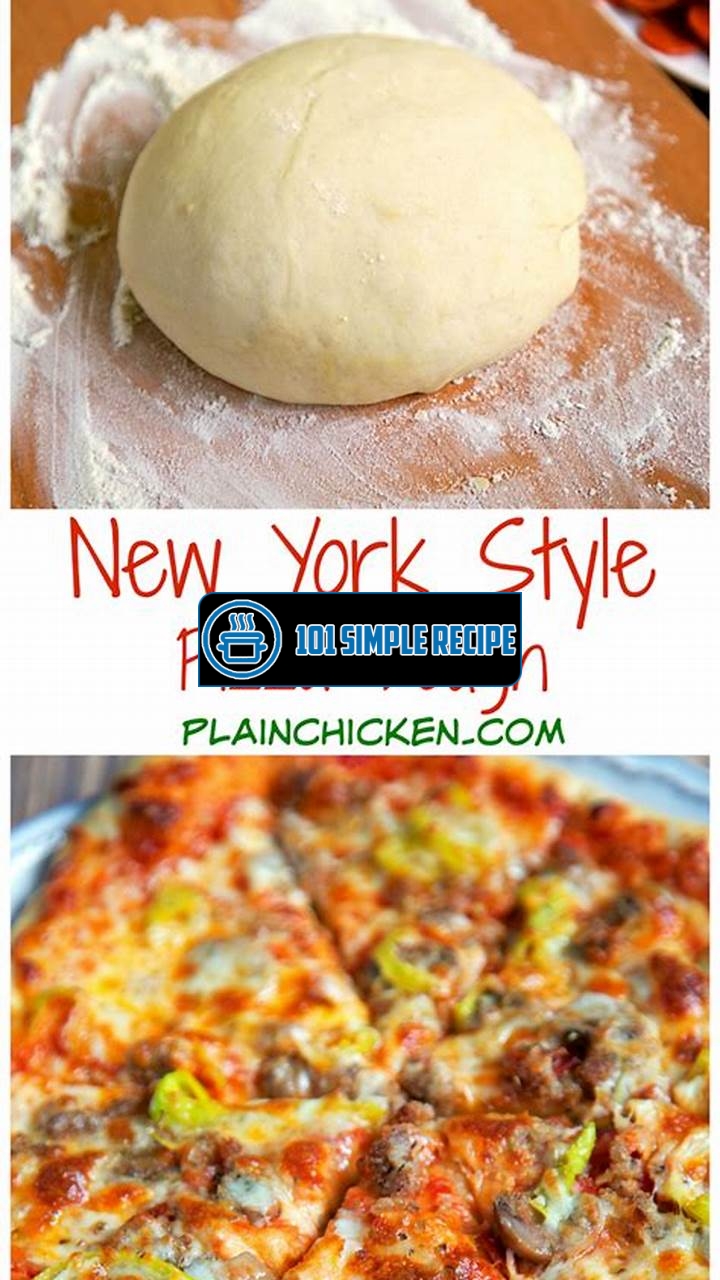Are you ready to learn the secrets behind creating the perfect New York-style pizza at home? Look no further, because we have got the ultimate guide for you! Making authentic thin crust pizza dough is an art form that requires precise techniques and quality ingredients. This recipe will take you step by step through the process, providing you with all the tips and tricks to achieve that classic New York pizza flavor. From the moment you take your first bite of this crispy, yet delightfully chewy dough, you’ll be transported to the bustling streets of the Big Apple. So grab your apron, roll up your sleeves, and get ready to impress your friends and family with your very own homemade New York-style pizza!

The History of New York Pizza
Explore the origins and cultural significance of New York pizza, a beloved culinary icon.
New York pizza holds a special place in the culinary landscape, and its history is as fascinating as the flavors it offers. Born in the late 19th century, New York pizza was heavily influenced by the Italian immigrants who settled in the city. These immigrants brought with them their traditional pizza-making techniques and recipes, which laid the foundation for the iconic New York-style pizza we know and love today.
The Influence of Italian Immigrants
The influx of Italian immigrants in the early 1900s played a crucial role in shaping the New York pizza scene. These immigrants, mainly from Naples and Sicily, introduced the thin crust style pizza. They established small pizzerias throughout the city and used local ingredients to create flavor-packed pizzas. The key to their success was the use of high-gluten bread flour, which resulted in a crisp yet chewy crust.
Another crucial aspect of New York pizza was the sauce. The simplicity of the traditional Neapolitan sauce – crushed tomatoes, olive oil, garlic, and a sprinkling of herbs – became the foundation for the rich, tangy tomato sauce used on New York pizzas.
The Birth of the Pizzerias
The early 20th century saw the rise of the first pizza shops in New York City. Lombardi’s, which opened in 1905 in Manhattan’s Little Italy neighborhood, is often credited as the first pizzeria in the United States. With its coal-fired brick oven and a distinct thin crust, Lombardi’s set the standard for New York pizza.
As time went on, more pizzerias opened up across the city, each bringing its own unique twist to the beloved dish. Names like Totonno’s, John’s Pizzeria, and Grimaldi’s gained popularity and became institutions in their respective neighborhoods.
Innovation: Pizza by the Slice
In the 1960s, the concept of selling pizza by the slice revolutionized the New York pizza scene. This innovation allowed people on the go to enjoy a quick, affordable, and delicious meal. Pizzerias started offering pre-cooked pizza slices displayed in glass counters, ready to be reheated and served. This concept quickly caught on and became synonymous with New York’s fast-paced lifestyle.
Today, New York pizza continues to thrive, with countless pizzerias serving up their unique takes on this iconic dish. From the traditional thin crust to various toppings and styles, New York pizza has evolved but remains deeply rooted in its history and immigrant influences.
Immigrant Influence on New York Pizza
The origins of New York pizza can be traced back to the Italian immigrants who brought their culinary traditions to the city. These immigrants introduced the concept of pizza to America and adapted their traditional recipes to suit local ingredients and tastes.
The Italian Connection
The story of New York pizza begins in Naples, Italy, where the Margherita pizza was born. This simple yet iconic pizza, topped with tomatoes, mozzarella cheese, and basil, served as the inspiration for the first New York-style pizzas.
Upon arriving in New York, Italian immigrants faced the challenge of replicating the flavors and textures of their homeland with the available ingredients. They traded the softer Italian flour for the higher protein bread flour commonly found in the United States. This change resulted in a crust that was crispy on the outside, yet chewy and foldable – a characteristic that has become synonymous with New York pizza.
The Legacy of Lombardi’s
As mentioned earlier, Lombardi’s pizzeria, opened by Gennaro Lombardi in 1905, marked the birth of New York-style pizza. Lombardi’s brick oven, thin crust, and flavorful toppings became the blueprint for future pizzerias in the city.
Soon, a new wave of Italian immigrants set up their own pizzerias, leaving their mark on the evolving New York pizza scene. Totonno’s, a legendary Brooklyn establishment, opened in 1924 and remains a beloved spot for pizza enthusiasts today. John’s Pizzeria, established in Manhattan’s Greenwich Village in 1929, is another classic pizzeria known for its coal-fired brick oven and family recipes passed down through generations.
Diverse Influences
While Italian immigrants shaped the foundation of New York pizza, the dish has also been influenced by subsequent waves of immigrants from different regions. Greek-American pizzeria owners introduced the spin of adding feta cheese to their pies, while New York’s Jewish community added their own twist with kosher pizza places.
These immigrant influences have not only enhanced the flavors of New York pizza but have also contributed to its cultural significance and the sense of community that surrounds it.
The Rise of Pizza by the Slice
The concept of pizza by the slice revolutionized the New York pizza scene, providing a convenient and affordable option for hungry New Yorkers on the go.
A Slice of Convenience
In the 1960s, pizzeria owners realized that selling individual slices would make pizza more accessible to a broader customer base. By pre-cooking whole pies and displaying them behind glass counters, pizzerias could offer customers the ability to order a single slice and have it quickly reheated.
The introduction of pizza by the slice not only catered to New Yorkers’ fast-paced lifestyle but also allowed customers to sample a variety of flavors without committing to a whole pie. This concept proved to be a massive success, and soon, pizzerias across the city started adopting the practice.
By the Slice, Always on the Rise
Today, pizza by the slice remains a quintessential aspect of New York’s culinary scene. Grabbing a slice from a street-side pizzeria or a late-night spot has become a rite of passage for locals and visitors alike.
Pizza places like Joe’s Pizza in Greenwich Village, Artichoke Basille’s Pizza, and Prince Street Pizza continue to serve up delectable slices, each with its own flavor profile and loyal following.
New York Pizza vs. Other Styles
New York pizza stands out from other pizza styles with its thin crust, large slices, and signature foldability. While every pizza lover may have their personal preference, understanding the key differences between New York pizza and other styles can enhance our appreciation for this iconic dish.
Neapolitan Pizza
Neapolitan pizza, originating in Naples, Italy, is characterized by its soft, chewy crust and minimal toppings. The dough is typically made with soft Italian flour and topped with fresh, high-quality ingredients. Neapolitan pizza is traditionally cooked in a wood-fired oven at a high temperature for a short duration.
Chicago Deep Dish Pizza
Chicago-style deep-dish pizza is a stark contrast to New York pizza. It features a thick, buttery crust that serves as a vessel for generous amounts of cheese, toppings, and chunky tomato sauce. The pizza is baked in a deep, round pan and has a more pie-like consistency.
California Pizza
California-style pizza is known for its thin, crispy crust and creative toppings. It often features non-traditional ingredients like goat cheese, arugula, and sun-dried tomatoes. The focus in California-style pizza is on using fresh, local produce and ingredients.
While these pizza styles all have their unique characteristics, New York pizza holds a special place in the hearts and taste buds of many. Its combination of thin, foldable crust, flavorful tomato sauce, and diverse toppings continues to make it an enduring culinary delight.
Whole Foods Chantilly Cake Recipe
The Significance of Dough in New York Pizza
In the world of pizza, New York-style pizza stands out for its iconic thin and crispy crust. The secret behind achieving that perfect crust lies in the dough. The dough is the foundation of a great pizza, and it plays a crucial role in determining the overall taste and texture.
One of the primary reasons why the dough is significant is its ability to provide that classic New York-style pizza experience. The thin crust allows the toppings and flavors to shine through without overwhelming the palate. It strikes the right balance between being crispy on the outside and soft and chewy on the inside. This delicate balance is what makes New York pizza so unique and loved by pizza enthusiasts around the world.
The Key Ingredients in New York Pizza Dough
To make authentic New York pizza dough, you’ll need a few key ingredients. The first and most important ingredient is high-gluten flour. This type of flour has a higher protein content, which helps create a sturdy and chewy dough. It also provides the necessary structure for the crust to hold up to the toppings.
In addition to high-gluten flour, other essential ingredients include water, yeast, salt, and olive oil. Water is necessary to activate the yeast and create the right consistency for the dough. Yeast is responsible for the dough’s rise and creates air pockets that contribute to its airy texture. Salt adds flavor and helps regulate the yeast’s activity, while olive oil adds richness and enhances the dough’s elasticity.
Mastering the Dough Mixing Techniques
Once you have gathered all the ingredients, the next step is mastering the dough mixing techniques. The goal is to develop the perfect balance of gluten formation and air incorporation. This can be achieved through a process called “hand kneading” or by using a stand mixer with a dough hook attachment.
Hand kneading involves using your hands to mix and knead the dough until it reaches the desired consistency. This method allows you to have better control over the dough’s texture and prevents overmixing, which can result in a tough crust.
If you choose to use a stand mixer, start by mixing the dry ingredients together and slowly adding the wet ingredients. Use the dough hook attachment and mix on low speed until the dough comes together. Once it forms a ball, increase the speed to medium and continue mixing for a few minutes until the dough becomes smooth and elastic.
Fermentation and the Secret to Flavorful Dough
After the dough is mixed, it’s time for fermentation, which is the secret to achieving a flavorful dough. Fermentation is the process where the yeast consumes the sugars in the dough, producing carbon dioxide and alcohol. This fermentation process creates pockets of air and develops complex flavors in the dough.
The dough should be left to rise at room temperature for at least 24 hours to allow for optimal flavor development. During this time, the yeast will continue to work its magic, resulting in a light and airy crust with a depth of flavor that sets New York pizza apart.
In conclusion, the significance of dough in New York pizza cannot be understated. It is the foundation on which the perfect crust is built, and it plays a critical role in achieving the iconic thin and crispy texture. By using the right ingredients, mastering the dough mixing techniques, and allowing for proper fermentation, you can create an authentic New York-style pizza crust that will impress even the most discerning pizza lovers.
King Arthur Pizza Dough Recipe
Secrets to the Perfect New York Pizza Dough Recipe
Creating authentic New York pizza dough at home is easier than you think! Follow this step-by-step process to achieve a thin crust that rivals the best pizzerias in the Big Apple. From choosing the right flour to mastering the art of kneading and stretching, we’ll guide you through the secrets of making the perfect New York pizza dough.
Choosing the Right Flour
The type of flour you use is crucial in achieving the authentic texture and flavor of New York pizza dough. Opt for high-protein bread flour, which provides the necessary gluten structure to create that signature chewiness. Avoid all-purpose flour, as it has a lower protein content and will result in a softer, less desirable crust.
Pro Tip: Look for flour labeled as “strong” or “high-gluten” for the best results.
The Art of Kneading and Stretching
Kneading is an essential step in developing gluten and creating a light, airy crust. Start by combining your flour, water, yeast, and salt in a bowl. Mix until a shaggy dough forms, and then transfer it to a clean, lightly floured surface.
Using the heel of your hand, push the dough away from you, fold it in half, and rotate it a quarter turn. Repeat this process for about 8-10 minutes, until the dough becomes smooth and elastic.
Pro Tip: Don’t rush the kneading process! Take your time to ensure the dough reaches the desired consistency.
After kneading, cover the dough with a damp cloth and let it rest for at least an hour. This allows the gluten to relax and makes it easier to stretch the dough without it springing back.
When it’s time to stretch the dough, lightly flour your work surface and place the dough on top. Using your fingers, gently press and stretch the dough from the center outwards, rotating it as you go. Aim for a thin, even crust, leaving the edges slightly thicker for that perfect New York-style bite.
Pro Tip: If the dough resists stretching, let it rest for a few minutes and try again.
Pro Tips for Achieving the Ideal Crust
Now that you have your stretched dough, it’s time to focus on achieving the ideal crust. One secret is to preheat your oven as high as it can go. A hot oven helps create a crisp, golden crust.
Another tip is to place your baking sheet or pizza stone in the oven while it preheats. This ensures that the dough hits a hot surface as soon as it goes in, resulting in a well-browned bottom.
Pro Tip: For an extra touch of flavor, brush the crust with olive oil and sprinkle it with a pinch of sea salt before baking.
Finally, keep a close eye on your pizza while it bakes. The thin crust of New York pizza cooks quickly, typically in just 8-10 minutes. Rotate the pizza halfway through to ensure even browning.
With the secrets of New York pizza dough revealed, you can now create your own delicious slice of the city’s iconic cuisine. Remember to use high-protein bread flour, master the art of kneading and stretching, and follow the pro tips for achieving the ideal crust. Your homemade New York-style pizza will be the envy of all your friends!
Beyond the Basics: Variations and Enhancements
Discover creative twists and additions to elevate your New York pizza dough recipe.
Whole Wheat and Gluten-Free Options
If you’re looking to add a healthy touch to your New York pizza dough, consider using whole wheat flour. Whole wheat flour contains more fiber, vitamins, and minerals compared to refined white flour, making it a nutritious choice. It adds a slightly nutty flavor to your dough, enhancing the overall taste of your pizza. Additionally, whole wheat flour has a lower glycemic index, which means it releases sugar into the bloodstream more slowly, keeping you full for longer and avoiding sugar crashes.
If you or someone you’re cooking for has a gluten intolerance or allergy, you can still enjoy New York-style pizza by using gluten-free flour. There are various gluten-free flour options available, such as almond flour, rice flour, and tapioca flour. Experiment with different combinations to find the one that suits your taste preferences.
Whole wheat flour and gluten-free variations can provide a healthier and allergy-friendly twist to your New York pizza dough recipe.
Incorporating Herbs and Spices
Adding herbs and spices to your New York pizza dough can enhance its flavor and take it to the next level. Common herbs used in pizza dough include dried oregano, basil, thyme, and rosemary. These herbs infuse the dough with their distinctive aromas and tastes. Sprinkle them into the dough while kneading for an even distribution.
Spices like garlic powder, onion powder, and red pepper flakes can also jazz up your dough. Garlic powder adds a savory kick, while onion powder provides a subtle sweetness. If you like a bit of heat, sprinkle some red pepper flakes for a spicy punch.
Incorporating herbs and spices can add depth and complexity of flavors to your New York pizza dough recipe.
Exploring Toppings and Cheese Combinations
While the focus is on the dough, the toppings and cheese play a crucial role in creating an authentic New York-style pizza. Traditional New York pizza is known for its thin crust and delicious combination of toppings. Classic options include pepperoni, mushrooms, onions, green peppers, and black olives.
However, feel free to get creative with your toppings. Experiment with fresh ingredients like arugula, cherry tomatoes, prosciutto, or even seafood. The key is to balance the flavors and ensure they complement the crust. Don’t overload your pizza with toppings, as it can make the crust soggy.
When it comes to cheese, a blend of mozzarella and provolone is commonly used for New York-style pizza. However, you can mix it up by adding other cheeses like cheddar, gouda, or feta. Different cheese combinations can elevate the taste and texture of your pizza.
Exploring different toppings and cheese combinations allows you to personalize your New York pizza and create unique flavor profiles.
Papa John’s Garlic Sauce Recipe
Perfecting the Baking Process: Oven, Temperature, and Time
Uncover the secrets to achieving that signature New York pizza texture and taste.
The Ideal Oven Setup for Home Pizza Making
When it comes to making authentic New York-style pizza at home, the right oven setup is crucial. While most home kitchens don’t have the luxury of a traditional brick oven, you can still achieve delicious results with a few key considerations.
First, make sure you are using a conventional oven that can reach high temperatures. Aim for a minimum temperature of 500°F (260°C), as this will help you achieve that coveted crispy crust. Preheating your oven for at least 30 minutes ensures that it reaches the desired temperature and allows for even baking.
It’s also important to use a pizza stone or steel in your oven setup. These tools help absorb and distribute heat, resulting in a more evenly cooked pizza. Place the stone or steel on the middle rack of your oven, allowing it to heat up along with the oven.
Another trick to consider is using a pizza peel or a large baking sheet dusted with flour or cornmeal. This will allow you to easily transfer the pizza onto the preheated stone or steel.
Note: The ideal oven setup for New York-style pizza at home includes a conventional oven, preheated to at least 500°F (260°C), with a pizza stone or steel and a pizza peel or baking sheet for easy transfer.
Perfecting the Bake: Temperature and Timing
Now that you have the right oven setup, it’s time to focus on the temperature and timing for baking your New York-style pizza.
For the best results, set your oven to the highest temperature it can reach, typically around 550°F (290°C). This high heat will help achieve that characteristic crispy yet chewy crust. Keep in mind that every oven is different, so you may need to experiment to find the perfect temperature for your setup.
The baking time will also vary depending on various factors, such as the thickness of your dough and the toppings used. As a general guideline, most New York-style pizzas take around 12-15 minutes to bake in a high-temperature oven. However, it’s crucial to keep a close eye on the pizza during the baking process to ensure it doesn’t over or undercook.
Once the pizza is golden brown and the cheese is melted and bubbling, it’s ready to be taken out of the oven. Allow the pizza to cool for a few minutes before slicing and serving to avoid burning your mouth.
Note: Set your oven to the highest temperature it can reach, typically around 550°F (290°C), and bake the pizza for around 12-15 minutes, or until the crust is golden brown and the cheese is melted and bubbling.
Reheating and Storage Tips for Leftover Pizza
One of the joys of making New York-style pizza at home is having leftovers for later. However, reheating leftover pizza can be tricky, as you want to maintain that crispy crust without drying out the toppings.
An effective method for reheating pizza is using a skillet on the stovetop. Place the slices in a dry skillet over medium-low heat and cover with a lid. This allows the heat to penetrate the crust while retaining moisture and ensuring an even reheating process. After a few minutes, you’ll have a hot and crispy pizza ready to enjoy.
When it comes to storing leftover pizza, it’s essential to wrap it tightly in plastic wrap or place it in an airtight container. This helps prevent drying out and keeps the crust from becoming soggy. Leftover pizza can be stored in the refrigerator for up to three days.
To reheat refrigerated pizza, avoid using the microwave, as it tends to make the crust rubbery. Instead, use the skillet method mentioned above or reheat it in a preheated oven at 350°F (175°C) until heated through.
Note: Reheat leftover pizza in a skillet on the stovetop, cover with a lid for even heating. Store leftover pizza tightly wrapped in plastic or an airtight container in the refrigerator for up to three days.
With these tips and tricks, you’ll be able to recreate the authentic New York pizza crust in your own kitchen. Remember to experiment and adjust the oven temperature and baking time according to your specific setup. Enjoy the delicious results and impress your friends and family with your homemade New York-style pizza.
Frequently Asked Questions
Here are some common questions about making New York-style pizza dough:
| No. | Questions | Answers |
|---|---|---|
| 1. | Why is New York pizza dough different? | New York pizza dough is known for its thin yet foldable crust, which is achieved by using high-gluten flour and a long fermentation process. This gives the dough a chewy texture and distinct flavor. |
| 2. | Can I use all-purpose flour instead of high-gluten flour? | While it’s best to use high-gluten flour for an authentic New York-style pizza dough, you can substitute with all-purpose flour if needed. The crust may not have the same chewiness, but it will still be delicious. |
| 3. | How long should I let the dough rise? | For the best results, let the dough rise in the refrigerator overnight or up to 24 hours. This slow fermentation process enhances the flavor and texture of the crust. |
| 4. | Can I freeze the dough? | Yes, you can freeze the dough for future use. After the initial rise, divide the dough into individual portions, wrap them tightly in plastic wrap, and store in the freezer for up to 3 months. |
| 5. | What toppings are traditional for a New York-style pizza? | Some classic toppings for a New York-style pizza include tomato sauce, mozzarella cheese, pepperoni, mushrooms, and green peppers. However, feel free to customize your pizza with your favorite ingredients. |
| 6. | Can I use a pizza stone for baking? | Yes, using a pizza stone can help achieve a crispier crust. Preheat the stone in the oven before baking the pizza to ensure even heat distribution. |
Thank You for Reading!
We hope you enjoyed learning how to make authentic New York-style pizza dough. Now that you have the recipe and tips, it’s time to get in the kitchen and start creating delicious homemade pizzas. Remember to visit our website again for more amazing recipes and culinary inspiration. Happy baking!
Jump to Recipe
New York Pizza Dough Recipe

Learn how to make authentic New York-style pizza dough with this easy recipe. The dough is thin, chewy, and full of flavor, just like the pizzas from your favorite New York pizzerias.
- 4 cups high-gluten flour
- 1 ½ teaspoons salt
- 2 teaspoons sugar
- 1 package active dry yeast
- 1 ½ cups warm water
- 2 tablespoons olive oil
- In a large mixing bowl, combine the flour, salt, and sugar. In a separate small bowl, dissolve the yeast in warm water and let it sit for a few minutes until foamy.
- Pour the yeast mixture and olive oil into the dry ingredients. Stir until a dough forms.
- Transfer the dough to a floured surface and knead for about 5 minutes until smooth and elastic. Place the dough in a greased bowl, cover with a damp cloth, and let it rise in the refrigerator overnight.
- When ready to use, remove the dough from the refrigerator and let it come to room temperature for about 30 minutes. Divide the dough into two equal portions.
- On a floured surface, roll out each portion of dough into a thin circle, about 12 inches in diameter. Transfer the dough to a pizza peel or baking sheet.
- Add your desired toppings to the dough, such as tomato sauce, cheese, and your favorite ingredients. Preheat the oven to 500°F (260°C).
- Carefully slide the pizza onto a preheated pizza stone or baking sheet and bake for about 10 minutes until the crust is golden and the cheese is bubbly.
- Remove the pizza from the oven and let it cool for a few minutes. Slice and serve hot.
- Enjoy your homemade New York-style pizza!






